
Dr. Shazia Rashid, Ph.D
HPV and Cervical Cancer: Prevention is Cure.
Knowledge, Attitude and Practice towards HPV Vaccine and Cervical Cancer among the College Students in India: According to WHO, cervical cancer is the fourth leading cause of deaths from cancer in women worldwide while in India it is a leading cancer among women. The principal cause for the development of cervical cancer is infection with specific high risk types of the Human papillomaviruses (HPVs). A variety of clinical and epidemiological factors such as early age of marriage, multiple sexual partners, multiple pregnancies, poor genital hygiene, smoking and the like are often associated with the development of cervical cancer.
Gardasil and Cervarix are two vaccines that have been introduced recently for primary prevention. They are used to vaccinate adolescent girls between the ages 9–14 and/or 15–26 years.
Vaccination should be initiated in young girls in the age group of 9 to 14 years although follow up vaccination up to 26 years is recommended. The dosage has been reduced from a 3 dose to a 2-dose schedule. This is because 2 doses have similar immunogenicity and induce comparable antibody titres when compared to 3 doses. Reduction in doses will lead to better compliance and will be more cost effective.
HPV Vaccination – Right Dose at Right Age:
9-14 years: 2 doses at least 6 months apart; interval between doses should not be greater than 12-15 months
15-26 years: 3 doses; HIV infected or immunocompromised women also need to follow the 3 doses schedule.
Quadrivalent & Nonavalent vaccine-0,2,6 months and Bivalent vaccine-0,1,6 months.
It is recommended that vaccinated women should be screened as per the standard guidelines because HPV 16 & 18 cause only 70% of cervical cancers and a woman could be infected with an HPV strain not present in the vaccine. Currently there is not enough data to suggest revised recommendations for vaccinated women but different guidelines for both the groups may be available in the future. Till then it is important to remember that vaccination and screening are complementary and neither should be omitted.
Despite these vaccines being reported as highly immunogenic, safe, well tolerated and effective in preventing infection, HPV vaccines are still not a part of the National Immunization Program in India. It has been observed that awareness about HPV and cervical cancer in India is very poor among the general population, even among the affluent and well-educated. An extremely low percentage of girls are vaccinated and not many parents are even interested in vaccinating their daughters. This attitude could be attributed to an array of reasons such as high cost of vaccines, societal, religious and cultural stigma and the fear of adverse effects from immunization. Many people are of the opinion that HPV vaccines would make sex safe, leading to promiscuity and change in sexual behavior in the younger generation, which is considered socially inappropriate. Another major reason is the general lack of awareness about the virus, the relevant vaccines and the prevalence and health implications of cervical cancer among the Indian population. Consequently only a small number of women are immunized at private clinics which can be accessed and afforded by the affluent sections of society.
It has been observed that awareness is also poor among the young, educated college-going adults although they are a part of the HPV infection chain and at risk since they lead more independent lives. This section of the population should exercise their choice to undergo vaccination with consent from parents because they are within the age limits of successful vaccination outcomes. Awareness campaigns should be targeted particularly towards young adults as studies indicate that imparting education has positive effects in encouraging and motivating men and women to participate in screening and vaccination programs. Not only can this lead to early diagnosis of the disease but also successful implementation of HPV immunization programs for control of cervical cancer. Studies have also highlighted that young adolescent boys and girls show a positive attitude towards HPV screening and vaccination for prevention of cervical cancer post educational intervention. HPV immunization in the western world is highly successful due to widespread vaccination drives and awareness programs initiated by the government and healthcare organizations. There is an imperative need for educational intervention to raise knowledge and awareness about HPV associated cancers & their prevention through vaccination in the young adolescent population of India. This will help reduce HPV infection and cervical cancer related stigma thereby enabling successful implementation of screening and vaccination programs. Consequently the burden of cervical cancer and associated mortality could be reduced. There has been suggestions for the incorporation of HPV vaccination in the National Immunization Program in India. This could also be integrated with the screening and National Cancer Control programs to overcome limitations of vaccine costs and poor awareness to bring about successful control of HPV- induced cervical and other cancers.
Recommendation:
Since the vaccines do not protect against all HPV types that can cause cervical cancer, girls vaccinated against HPV will still require cervical cancer screening later in their lives.
Dr. Shazia Rashid, Ph.D (Biomedical Sciences), University of Ulster, U.K.
April 19, 2017
Reference:
– PLoS One. 2016 Nov 18;11(11):e0166713. doi: 10.1371/journal.pone.0166713. eCollection 2016.
Knowledge, Awareness and Attitude towards HPV, HPV Vaccine and Cervical Cancer among the College Students in India.
https://www.ncbi.nlm.nih.gov/pubmed/27861611






